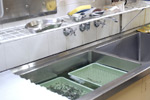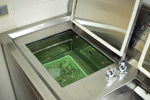Equipment / Instruments
Unit 10: Cleaning & Sterilizing
Topic 1: Cleaning of Surgical Instruments
Surgical instruments and re-usable equipment to be sterilised must first be cleaned to remove dried blood and tissue which may conceal microbes. Thorough cleaning to remove all soil and organic material can reduce the bioburden by 99.9%. This must be performed in a manner which will minimize damage to the instrument, and maintain its proper function.
Immediately following surgery, instruments should be rinsed in cold water, then placed in warm water containing an effective detergent (Sonident, a detergent solution for 20 minutes, or if very soiled, in a solution of Endozyme, an enzymatic agent).
Cleaning of less accessible parts may be aided by manual cleaning with a hand brush or an ultrasonic cleaner. Abrasive agents such as wire brushes and steel wool should never be used.
Ultrasonic cleaners clean via the process of cavitation in which minute gas bubbles are formed by ultrasonic waves (In excess of 20,000 oscillations per second). These expand underneath the dirt and debris until they become unstable, then collapse, creating a vacuum which helps remove tightly bound material.
Absorbent materials such as plastic and rubber cannot be cleaned in this way as these materials absorb the vibrations.

Remember:
- When processing instruments and equipment, the safety of staff must always be taken into account when establishing standard procedures.
- Personal protective equipment (PPE) including chemical resistant gloves, eye protection and waterproof aprons should be used when processing contaminated materials and using some disinfectant solutions.
- Procedures are required for handling biological wastes and sharp items, such as bloodied swabs, scalpel blades and needles.
- Never place your hand into the ultrasonic cleaner whilst it is working as injury to joints may occur.
The instruments are then inspected for any damage.
The routine use of lubricants is not recommended as they are a potential source of contamination. If lubrication is required, then a water miscible one, recommended by the manufacturer should be used.


